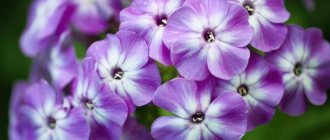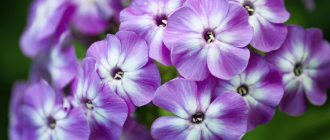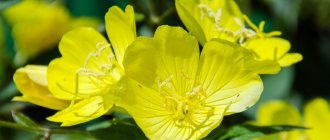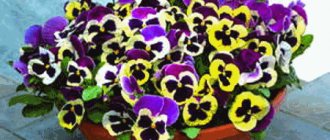Phlox Drummond: growing seedlings
When to plant Phlox Drummond seeds? In order for phlox to bloom in June, the seeds need to be sown no later than April, and preferably earlier. How to properly plant seed material will be discussed further.
Growing Drummond phlox seedlings occurs in several stages:
- Phlox seeds can be sown in plastic containers with transparent lids. The seedlings will develop well in them. The microclimate there is like in a small greenhouse: warm and humid. At the bottom of the container, you need to drill holes with a hot awl and fill them with soil. You can germinate the seeds first - this will speed up the germination process.
- Before sowing, it is useful to first hold the seeds in a damp cloth. Seeds are sown in 2-3 pieces at a distance of 15 cm, deepening by 1.5 cm. Seedlings appear in a week. During the dive, weak plants are removed, leaving only one.
- To prepare the substrate, you need to mix the purchased flower soil and sand equally. The substrate does not need to be poured to the top of the container. It is necessary that 2 cm remain from the top layer of soil to the edge of the container. It is necessary to water so that the soil does not dry out, but there is no need to allow it to overflow, otherwise rotting of the horse system may occur.
- Every day you need to open the lid to ventilate the crops, make sure that there is no mold and condensation does not accumulate. You can sow phlox seeds in another suitable container and cover with film.
- After three true leaves appear, the seedlings are planted in separate pots or containers, divided into cells.
- After picking, it is advisable to feed the plant with complex mineral fertilizer for flowers.
- For bushiness, pinch 4-5 leaves.
How to plant Drummond phlox? Seedlings should be planted in the garden after the last frost. Typically at the end of May or beginning of June. When planting, the distance between plants should be from 15 to 20 cm.
At first, it is necessary to protect the plants from direct sunlight. Depending on the plant variety, it grows up to 25-60cm.
Planting and care in open ground
Site preparation
Annual Drummond phloxes are unpretentious, but it is better to plant them in an area where there will be partial shade at noon. Direct sunlight has a negative effect on flowering.
The soil for annual plants should be of medium acidity, fertile and light. Sand, peat, and organic matter are added to heavy soils.
Holes for planting Drummond phlox are made at a distance of 20 cm from each other. The soil from the hole is mixed with wood ash, which will need about 150 grams for each plant. The seedlings, together with a lump of earth, are placed in a hole, sprinkled with nutritious soil and watered abundantly. To prevent the soil around the plantings from drying out, it is sprinkled with mulch.
Features of care
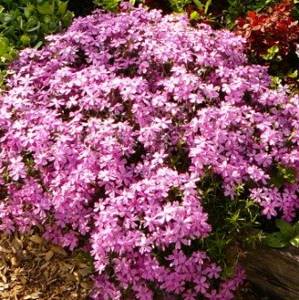
Drummond phloxes do not tolerate drought, so they should be watered regularly, especially after planting the seedlings in the ground. If the soil in a flower bed regularly dries out, the buds will begin to fall off and the flowers will wither. However, the soil should not be constantly damp. It should be watered only after the top layer has dried. If it rains regularly in the summer, then water the flowers only as needed. After watering or rain, it is necessary to pull out the weeds and loosen the soil shallowly.
For abundant flowering, phloxes need fertilizing, which can be used as organic matter and mineral fertilizers. It is not recommended to use manure and nitrogen-containing fertilizers, otherwise annuals will grow green and flowering will be very poor. During the season, Drummond phlox will need to be fed 4 times.
You will be interested to know: Osteospermum: growing from seeds, when to plant seedlings, photo
In order for the bushes to branch and become lush, it is recommended to regularly pinch the shoots. For long-lasting flowering, faded buds should be removed immediately. If seeds are needed, it is recommended to leave a few of the best flowers.
When the seed pod turns yellow, it is picked and dried. Until planting in the spring, the seeds are stored in paper bags.
Landing location
Drummond phloxes bloom well in flower beds and mixed borders. It is advisable to plant them with spring flowers. When the primroses fade, the phloxes will cover the empty space with their lush blooms. It is useful to plant phlox near the porch or in a portable planter.
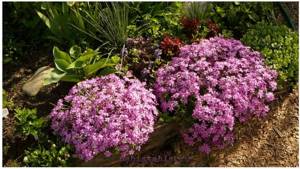
In cool climates, it is better to plant phlox in a well-lit, sunny place. In the southern regions, Drummond phlox is best grown in partial shade. In addition, in the south, plants can be insulated with non-woven material for the winter, and the next summer they will grow and bloom, only less abundantly.
On a note!!!
Despite the fact that the plant is cold-resistant and is not afraid of cool weather, it is advisable to plant it in a well-lit area with light shading.
The soil

Land for planting can be taken from the garden bed, adding a little river sand and peat to it. If the soil is acidic, you will have to add lime or ash. In sandy soil, plant roots can overheat in hot weather.
Moisture can stagnate in clay soil, which will lead to rotting of the roots. For the same reason, an area with high groundwater levels is not suitable for planting phlox.
Fertile and well-drained soil is ideal.
Phlox annual: seeds
If you cut off all the faded inflorescences in time, the bushes will quickly grow new shoots, which will also have time to bloom. Phlox can bloom until cold weather persists.
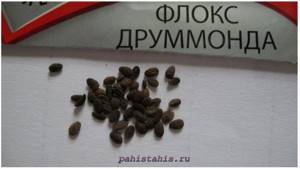
After flowering, phlox set numerous seeds. When the seed shell becomes yellowish, you need to cut off the inflorescence on a sunny day and put them in a box with a loose lid. Keep the box in a warm, dry place. In the box, the twigs with seeds are completely dry. And next year, such seeds can be used to plant Drummond phlox.
Botanical features and varietal diversity
Phlox belongs to the Blue family and has about forty cultivated species. And only Drummond's phlox is one of a kind! - annual plant. However, it is in no way inferior in beauty to its long-term “brothers”.
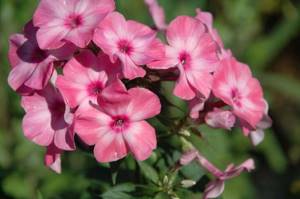
Phlox blooming
Annuals are conventionally divided into 2 groups:
Large-flowered. Plants have large, six-centimeter inflorescences. The height of the stems starts from 30 cm and reaches 60 cm. They are excellent for cutting and look great in a flower garden.
Dwarf. Miniature phloxes are only 15–20 cm high and have numerous small flowers. Ideal for border plantings, edging paths and dividing flower zones.
Annual representatives of the family are distinguished by erect, branching stems. The leaves are oblong, arranged in pairs, one opposite the other.
The seeds are small, about 3 mm, oval in shape, brown in color and have a high germination rate. They are very convenient to prepare. They ripen in boxes left after the buds wither. In order to have time to collect them, you should not wait until they are fully ripe, because the fruit will burst and the “babies” will scatter.
To obtain planting material, you need to cut off the immature achenes, place them in a paper envelope and place them in a dry and warm place. The shell will dry out and crack, but the grains will remain in the bag.
Under favorable conditions, such as a warm and snowy winter, annual phloxes give good self-seeding.
Numerous round or star-shaped flowers are collected in bunches. The structure can be simple or terry. They have a light unobtrusive aroma. You can choose either a two-color or a single color. The color scheme includes white, purple, yellow, red, blue, and crimson shades that will decorate the garden from June until the onset of frost. Although the buds look rather fragile, they are not at all afraid of rain, like, for example, petunias.
Phlox Drummond - a low-demanding plant
Phlox Drummond is a low-demanding plant, heat-loving, but can withstand frosts down to -2°.
It is devoted to the bright sun and grows well in almost any moderately moist soil. Avoid planting in shady and marshy areas.
Among flower growers, the following varieties have earned the greatest popularity:
Star Rain. Tall (50 cm) bush, blooming with numerous stars. The diameter of the bud reaches 2 cm. It is colored in various shades of red and pink. It has a fragrant aroma.
Bird's milk. A miniature plant 15-20 cm high. The inflorescences are creamy-white, double. It stands out for its abundant and long-lasting flowering.
Sunny bunny. A medium-sized representative of the family. It stands out with soft lemon simple flowers, the size of which is about 3 cm.
Leopold. Coral, round, large-flowered buds with a white core on a high stem. Large-flowered variety. Relatively cold-resistant and drought-resistant species.
Blue velvet. The exquisite, violet-blue caps of the inflorescences reach a diameter of 15 centimeters. Phlox is compact, its height is only 20 cm.
Kaleidoscope. A colorful mixture of border phlox. The buds are wheel-shaped, uniform in color, with a clear central eye.
Promise. Low-growing (up to 30 cm) specimen. Double flowers, of various shades. They do not fade in the sun, remaining bright and saturated throughout the growing season.
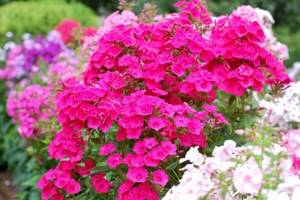
Phloxes are present in almost every summer cottage
The list of interesting varieties can be endless, because breeders create new species every year. But no matter which phlox is chosen, the cultivation conditions are the same for all.
Sowing seeds in autumn
Drummond phlox seeds can withstand low temperatures. Only the seeds need to be sown on time. If sown early, the seeds will germinate and then die from frost. They need to be sown when the last leaves fall from the cherry tree.
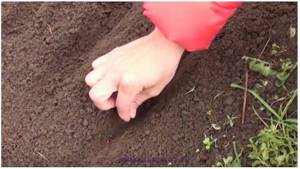
In any case, it is better to cover the crops with non-woven material. In the southern regions, seeds can be sown even in February. After a snowfall, rows are made in which the seeds are placed. The plantings are covered with fertile soil and covered with a 20 cm layer of snow. Until warm days, the seeds will remain dormant. Sprouts will appear in April.
Phlox Drummond: varieties
Phlox Drummond belongs to the Phlox species and the Sinyukhov family. A very popular garden plant. And there are a huge number of popular varieties. Among them are the following:
Phlox drummond Strawberry and cream

The flowers are mahogany with a bright and juicy color of red and white. The bushes are compact, reaching a height of 25 cm. Flowering is abundant. The flower size is 3 cm in diameter. The flowers are collected in corymbose inflorescences. Flowering period from late June to October.
Phlox Drummond Star Rain

Its small flowers look like stars. The plant reaches a height of 50 cm, the colors are very different: red, white, blue, purple, pink, etc. There are flowers with a white border around the edge, with a white stripe in the middle, or with a white center. Unpretentious in care. They bloom from June until frost. It should be grown in an open sunny area.
Phlox Drummond Buttons
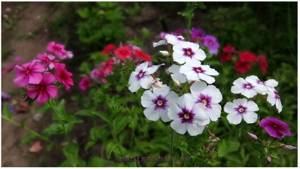
The plant is not tall. It reaches a height of 25 cm. The flowers are two-color, flat. In the middle is one color, and around the edges is another. Blooms profusely until frost. Unpretentious. Suitable for decorating flower beds and ridges. Biennial.
Phlox Drummond Charm
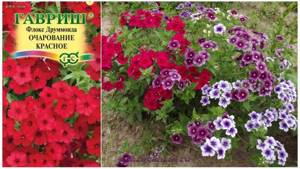
Similar to Buttons variety. Annual. The bush is lush and branched. The flowers are collected in flat corymbose inflorescences. Blooms until late autumn. It is highly decorative. It is best to grow flowers in seedlings. Seeds are sown in April, seedlings are planted in the soil at the end of May.
Phlox Drummond Grandiflora

The plant grows up to 35 cm in height. It branches strongly from the stem. Flowers are 2-2.5 cm in diameter. The colors are very varied. Flowers are collected in thyroid inflorescences. The plant is not afraid of rain and minor frosts. Light- and heat-loving. Relatively drought-resistant. In order for phlox to bloom well, timely watering and removal of wilted inflorescences are required.
Phlox Drummond Tetra Riesen
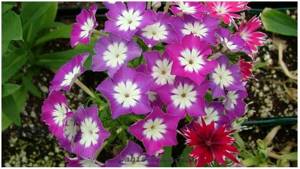
The flowers are large, up to 4 cm in diameter, and have various shades of blue and white. Cold resistant. They have a wide variety of shades. Grows up to 40 cm. Flowering profusely. They can decorate any flower bed. They look good on the porch and along the walls, in the flower bed.
Phlox Drummond Tapestry

It is also called elegant phlox. Flowers of a wide variety of colors. The variety tolerates winter frosts well. This variety, like the others, blooms until frost. Propagated by seeds. Shoots can be seen on the 15th day. It is planted in the ground according to a 20x30 cm pattern. In order for the plant to bloom profusely, it should be fed regularly.
Phlox Drummond Art shades

Low growing variety. The bush is lush and highly branched, usually growing up to 45 cm in height. The flowers are collected in an umbrella-shaped inflorescence. The coloring is varied. White stripes similar to spider legs extend from the center. The variety is highly decorative. It shows its beauty best in fertile soil and sunny areas.
Drummond phlox bushes will decorate any corner of the garden; they do not require special care.
Caring for Drummond Phlox
In order to admire the flowering of the plant from June until the first frost, you should properly care for it.
We recommend reading:
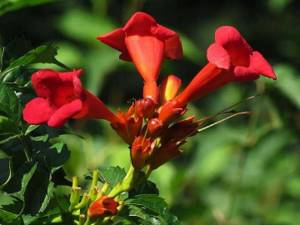
Campsis - planting, care, use in decoration and tips on how to grow a plant in open ground correctly (120 photos)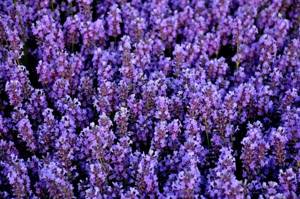
Lavender: application ideas, growing rules and propagation features (105 photos + video)
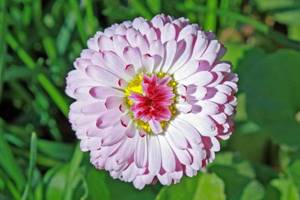
Perennial daisy: rules for planting and care in open ground. Features of using daisies in garden decoration (145 photos and videos)

It is important not to allow the soil to become waterlogged and to ensure that the annual plant receives enough sunlight.
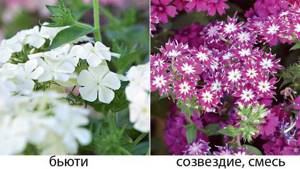
In dampness and shade, phlox will begin to hurt and rot. It is better to place flowering bushes on a small hill, where moisture does not have time to linger and where the rays of the sun first arrive.
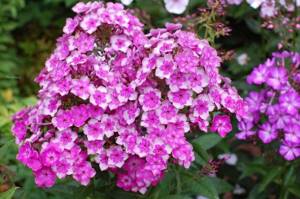
Before planting a plant in open ground, it is necessary to prepare it. It should be moderately nutritious and loose. Drummond will die in clay soil or sand.
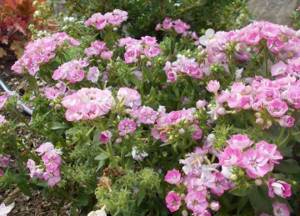
Phlox easily tolerate single frosts down to -3°C. After short-term exposure to low temperatures, the plant quickly recovers.
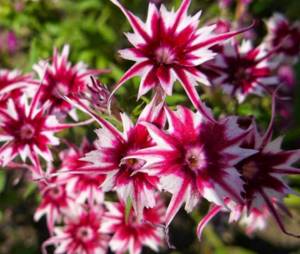
When viewing a photo of Drummonda, no one will have any doubt about the extraordinary beauty of this plant. Phlox flowers are not only aesthetically attractive, but also very fragrant. The main thing is to take care of proper care and follow the planting rules.


